Tutorial
Compare tree height measured from the ground to a Lidar-based Canopy Height Model
Authors: Claire K. Lunch
Last Updated: Feb 6, 2024
This data tutorial provides instruction on working with two different NEON data products to estimate tree height:
- DP3.30015.001, Ecosystem structure, aka Canopy Height Model (CHM)
- DP1.10098.001, Vegetation structure
The are derived from the Lidar point cloud data collected by the remote sensing platform. The are collected by by field staff on the ground. We will be using data from the Wind River Experimental Forest NEON field site located in Washington state. The predominant vegetation there are tall evergreen conifers.
If you are coming to this exercise after following tutorials on data download and formatting, and therefore already have the needed data, skip ahead to section 4.
Things You鈥檒l Need To Complete This Tutorial
You will need the most current version of R loaded on your computer to complete this tutorial.
1. Setup
Start by installing and loading packages (if necessary) and setting
options. One of the packages we'll be using, geoNEON, is only
available via GitHub, so it's installed using the devtools package.
The other packages can be installed directly from CRAN.
Installation can be run once, then periodically to get package updates.
install.packages("neonUtilities")
install.packages("neonOS")
install.packages("terra")
install.packages("devtools")
devtools::install_github("NEONScience/NEON-geolocation/geoNEON")
Now load packages. This needs to be done every time you run code. We'll also set a working directory for data downloads.
library(terra)
library(neonUtilities)
library(neonOS)
library(geoNEON)
options(stringsAsFactors=F)
# set working directory
# adapt directory path for your system
wd <- "~/data"
setwd(wd)
2. Vegetation structure data
Download the vegetation structure data using the loadByProduct() function in
the neonUtilities package. Inputs to the function are:
-
dpID: data product ID; woody vegetation structure = DP1.10098.001 -
site: (vector of) 4-letter site codes; Wind River = WREF -
package: basic or expanded; we'll download basic here -
release: which data release to download; we'll use RELEASE-2023 -
check.size: should this function prompt the user with an estimated download size? Set toFALSEhere for ease of processing as a script, but good to leave as defaultTRUEwhen downloading a dataset for the first time.
Refer to the cheat sheet
for the neonUtilities package for more details and the complete index of
possible function inputs.
veglist <- loadByProduct(dpID="DP1.10098.001",
site="WREF",
package="basic",
release="RELEASE-2023",
check.size = FALSE)
Use the getLocTOS() function in the geoNEON package to get
precise locations for the tagged plants. Refer to the package
documentation for more details.
vegmap <- getLocTOS(veglist$vst_mappingandtagging,
"vst_mappingandtagging")
Now we have the mapped locations of individuals in the vst_mappingandtagging
table, and the annual measurements of tree dimensions such as height and
diameter in the vst_apparentindividual table. To bring these measurements
together, join the two tables, using the joinTableNEON() function from the
neonOS package. Refer to the
for Vegetation structure for more information about the data tables and the
joining instructions joinTableNEON() is using.
veg <- joinTableNEON(veglist$vst_apparentindividual,
vegmap,
name1="vst_apparentindividual",
name2="vst_mappingandtagging")
Let's see what the data look like! Make a stem map of the plants in
plot WREF_075. Note that the circles argument of the symbols() function expects a radius, but
stemDiameter is just that, a diameter, so we will need to divide by two.
And stemDiameter is in centimeters, but the mapping scale is in meters,
so we also need to divide by 100 to get the scale right.
symbols(veg$adjEasting[which(veg$plotID=="WREF_075")],
veg$adjNorthing[which(veg$plotID=="WREF_075")],
circles=veg$stemDiameter[which(veg$plotID=="WREF_075")]/100/2,
inches=F, xlab="Easting", ylab="Northing")
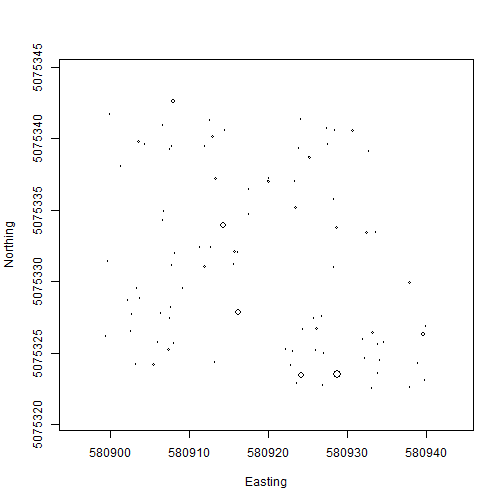
And now overlay the estimated uncertainty in the location of each stem, in blue:
symbols(veg$adjEasting[which(veg$plotID=="WREF_075")],
veg$adjNorthing[which(veg$plotID=="WREF_075")],
circles=veg$stemDiameter[which(veg$plotID=="WREF_075")]/100/2,
inches=F, xlab="Easting", ylab="Northing")
symbols(veg$adjEasting[which(veg$plotID=="WREF_075")],
veg$adjNorthing[which(veg$plotID=="WREF_075")],
circles=veg$adjCoordinateUncertainty[which(veg$plotID=="WREF_075")],
inches=F, add=T, fg="lightblue")
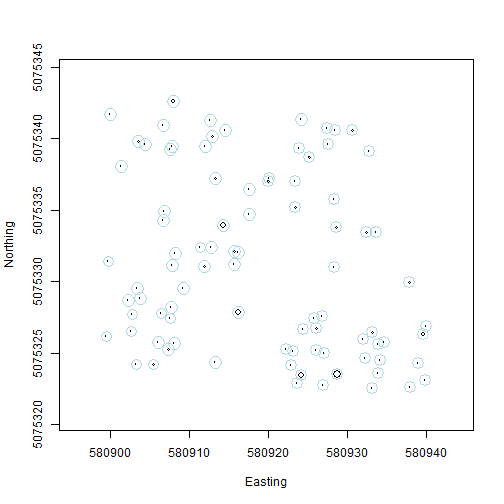
3. Canopy height model data
Now we'll download the CHM tile covering plot WREF_075. Several other plots are also covered by this tile. We could download all tiles that contain vegetation structure plots, but in this exercise we're sticking to one tile to limit download size and processing time.
The tileByAOP() function in the neonUtilities package allows for
download of remote sensing tiles based on easting and northing
coordinates, so we'll give it the coordinates of all the trees in
plot WREF_075 and the data product ID, DP3.30015.001 (note that if
WREF_075 crossed tile boundaries, this code would download all
relevant tiles).
The download will include several metadata files as well as the data
tile. Load the data tile into the environment using the terra package.
byTileAOP(dpID="DP3.30015.001", site="WREF", year="2017",
easting=veg$adjEasting[which(veg$plotID=="WREF_075")],
northing=veg$adjNorthing[which(veg$plotID=="WREF_075")],
check.size=FALSE, savepath=wd)
chm <- rast(paste0(wd, "/DP3.30015.001/neon-aop-products/2017/FullSite/D16/2017_WREF_1/L3/DiscreteLidar/CanopyHeightModelGtif/NEON_D16_WREF_DP3_580000_5075000_CHM.tif"))
Let's view the tile.
plot(chm, col=topo.colors(5))
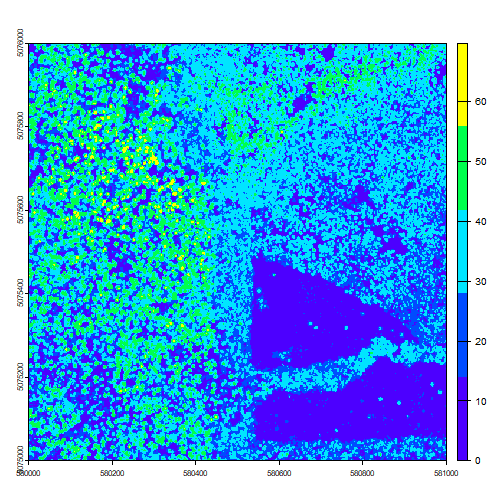
4. Comparing the two datasets
Now we have the heights of individual trees measured from the ground, and the height of the top surface of the canopy, measured from the air. There are many different ways to make a comparison between these two datasets! This section will walk through three different approaches.
First, subset the vegetation structure data to only the trees that fall
within this tile, using the ext() function from the terra package.
This step isn't strictly necessary, but it will make the processing faster.
vegsub <- veg[which(veg$adjEasting >= ext(chm)[1] &
veg$adjEasting <= ext(chm)[2] &
veg$adjNorthing >= ext(chm)[3] &
veg$adjNorthing <= ext(chm)[4]),]
Starting with a very simple first pass: use the extract() function
from the terra package to get the CHM value matching the coordinates
of each mapped plant. Then make a scatter plot of each tree's height
vs. the CHM value at its location.
valCHM <- extract(chm,
cbind(vegsub$adjEasting,
vegsub$adjNorthing))
plot(valCHM$NEON_D16_WREF_DP3_580000_5075000_CHM~
vegsub$height, pch=20, xlab="Height",
ylab="Canopy height model")
lines(c(0,50), c(0,50), col="grey")
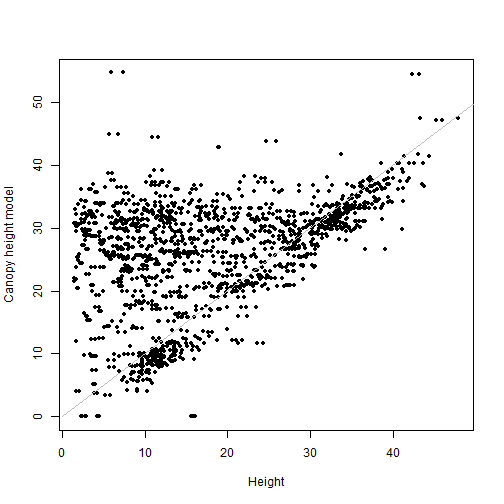
How strong is the correlation between the ground and lidar measurements?
cor(valCHM$NEON_D16_WREF_DP3_580000_5075000_CHM,
vegsub$height, use="complete")
## [1] 0.3824467
Now we remember there is uncertainty in the location of each tree, so the precise pixel it corresponds to might not be the right one. Let's try adding a buffer to the extraction function, to get the tallest tree within the uncertainty of the location of each tree.
valCHMbuff <- extract(chm,
buffer(vect(cbind(vegsub$adjEasting,
vegsub$adjNorthing)),
width=vegsub$adjCoordinateUncertainty),
fun=max)
plot(valCHMbuff$NEON_D16_WREF_DP3_580000_5075000_CHM~
vegsub$height, pch=20, xlab="Height",
ylab="Canopy height model")
lines(c(0,50), c(0,50), col="grey")
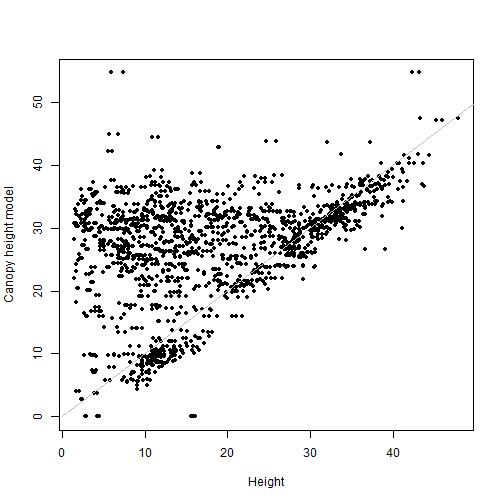
cor(valCHMbuff$NEON_D16_WREF_DP3_580000_5075000_CHM,
vegsub$height, use="complete")
## [1] 0.3698753
Adding the buffer has actually made our correlation slightly worse. Let's think about the data.
There are a lot of points clustered on the 1-1 line, but there is also a cloud of points above the line, where the measured height is lower than the canopy height model at the same coordinates. This makes sense, because the tree height data include the understory. There are many plants measured in the vegetation structure data that are not at the top of the canopy, and the CHM sees only the top surface of the canopy.
This also explains why the buffer didn't improve things. Finding the highest CHM value within the uncertainty of a tree should improve the fit for the tallest trees, but it's likely to make the fit worse for the understory trees.
How to exclude understory plants from this analysis? Again, there are many possible approaches. We'll try out two, one map-centric and one tree-centric.
Starting with the map-centric approach: select a pixel size, and aggregate both the vegetation structure data and the CHM data to find the tallest point in each pixel. Let's try this with 10m pixels.
Start by rounding the coordinates of the vegetation structure data, to create
10m bins. Use floor() instead of round() so each tree ends up in the pixel
with the same numbering as the raster pixels (the rasters/pixels are
numbered by their southwest corners).
easting10 <- 10*floor(vegsub$adjEasting/10)
northing10 <- 10*floor(vegsub$adjNorthing/10)
vegsub <- cbind(vegsub, easting10, northing10)
Use the aggregate() function to get the tallest tree in each 10m bin.
vegbin <- stats::aggregate(vegsub,
by=list(vegsub$easting10,
vegsub$northing10),
FUN=max)
To get the CHM values for the 10m bins, use the terra package version
of the aggregate() function. Let's take a look at the lower-resolution
image we get as a result.
CHM10 <- terra::aggregate(chm, fact=10, fun=max)
plot(CHM10, col=topo.colors(5))
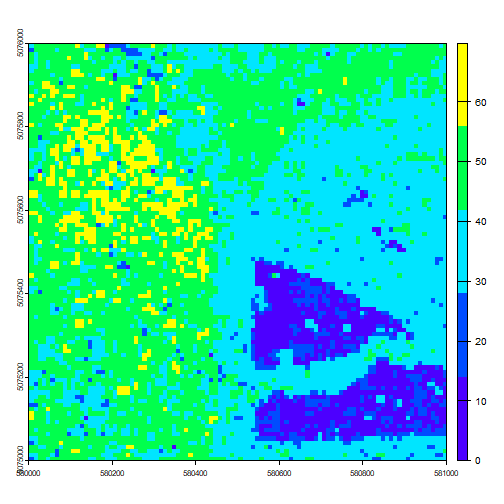
Use the extract() function again to get the values from each pixel.
Our grids are numbered by the corners, so add 5 to each tree
coordinate to make sure it's in the correct pixel.
vegbin$easting10 <- vegbin$easting10 + 5
vegbin$northing10 <- vegbin$northing10 + 5
binCHM <- extract(CHM10, cbind(vegbin$easting10,
vegbin$northing10))
plot(binCHM$NEON_D16_WREF_DP3_580000_5075000_CHM~
vegbin$height, pch=20,
xlab="Height", ylab="Canopy height model")
lines(c(0,50), c(0,50), col="grey")
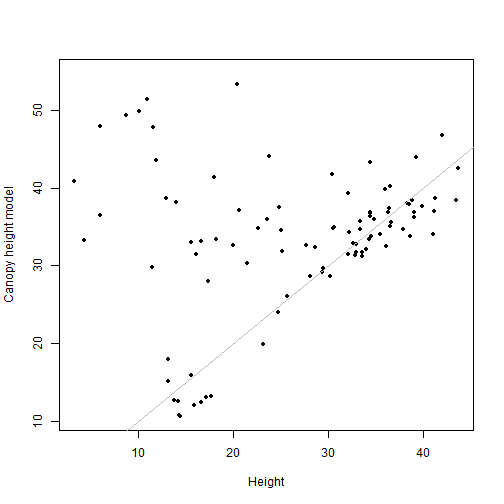
cor(binCHM$NEON_D16_WREF_DP3_580000_5075000_CHM,
vegbin$height, use="complete")
## [1] 0.2244228
The understory points are thinned out substantially, but so are the rest. We've lost a lot of data by going to a lower resolution.
Let's try and see if we can identify the tallest trees by another approach, using the trees as the starting point instead of map area. Start by sorting the veg structure data by height.
vegsub <- vegsub[order(vegsub$height,
decreasing=T),]
Now, for each tree, let's estimate which nearby trees might be beneath its canopy, and discard those points. To do this:
- Calculate the distance of each tree from the target tree.
- Pick a reasonable estimate for canopy size, and discard shorter trees within that radius. The radius I used is 0.3 times the height, based on some rudimentary googling about Douglas fir allometry. It could definitely be improved on!
- Iterate over all trees.
We'll use a simple for loop to do this:
vegfil <- vegsub
for(i in 1:nrow(vegsub)) {
if(is.na(vegfil$height[i]))
next
dist <- sqrt((vegsub$adjEasting[i]-vegsub$adjEasting)^2 +
(vegsub$adjNorthing[i]-vegsub$adjNorthing)^2)
vegfil$height[which(dist<0.3*vegsub$height[i] &
vegsub$height<vegsub$height[i])] <- NA
}
vegfil <- vegfil[which(!is.na(vegfil$height)),]
Now extract the raster values, as above.
filterCHM <- extract(chm,
cbind(vegfil$adjEasting,
vegfil$adjNorthing))
plot(filterCHM$NEON_D16_WREF_DP3_580000_5075000_CHM~
vegfil$height, pch=20,
xlab="Height", ylab="Canopy height model")
lines(c(0,50), c(0,50), col="grey")
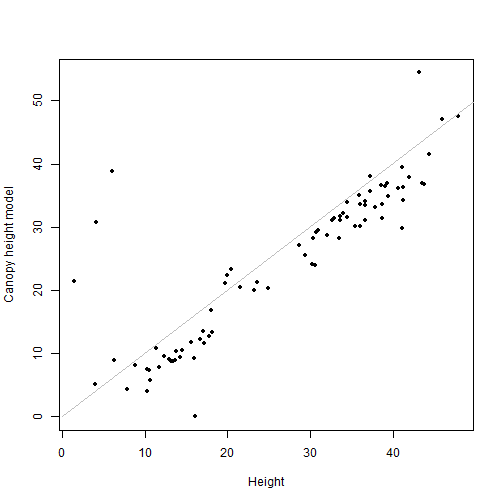
cor(filterCHM$NEON_D16_WREF_DP3_580000_5075000_CHM,
vegfil$height)
## [1] 0.8070586
This is quite a bit better! There are still several understory points we failed to exclude, but we were able to filter out most of the understory without losing so many overstory points.
Let's try one last thing. The plantStatus field in the veg structure data
indicates whether a plant is dead, broken, or otherwise damaged. In theory,
a dead or broken tree can still be the tallest thing around, but it's less
likely, and it's also less likely to get a good Lidar return. Exclude all
trees that aren't alive:
vegfil <- vegfil[which(vegfil$plantStatus=="Live"),]
filterCHM <- extract(chm,
cbind(vegfil$adjEasting,
vegfil$adjNorthing))
plot(filterCHM$NEON_D16_WREF_DP3_580000_5075000_CHM~
vegfil$height, pch=20,
xlab="Height", ylab="Canopy height model")
lines(c(0,50), c(0,50), col="grey")
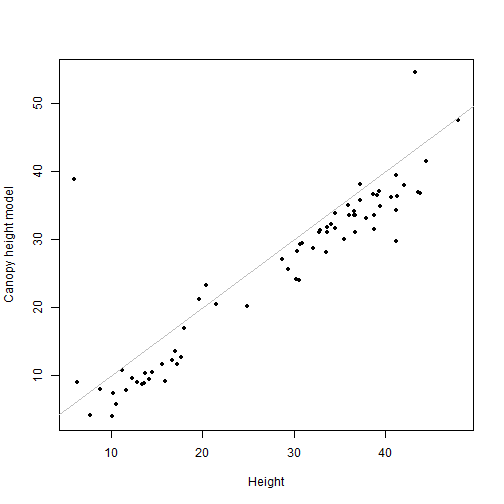
cor(filterCHM$NEON_D16_WREF_DP3_580000_5075000_CHM,
vegfil$height)
## [1] 0.9057883
Nice!
One final note: however we slice the data, there is a noticeable bias even in the strongly correlated values. The CHM heights are generally a bit shorter than the ground-based estimates of tree height. There are two biases in the CHM data that contribute to this. (1) Lidar returns from short-statured vegetation are difficult to distinguish from the ground, so the "ground" estimated by Lidar is generally a bit higher than the true ground surface, and (2) the height estimate from Lidar represents the highest return, but the highest return may slightly miss the actual tallest point on a given tree. This is especially likely to happen with conifers, which are the top-of-canopy trees at Wind River.